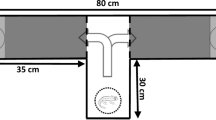Summary
Snails were tested in an olfactometer for their orientation to food odours. Measures of odour choice, latency to make a choice and percentage of upwind orientations were obtained after experimental manipulations of dietary experience and hunger motivation. Juvenile snails, given an exclusive diet of a certain food for 12 h or less, oriented preferentially toward the odour of that food when subsequently presented with a choice between it and a novel food odour (Fig. 2). A 48 h period of exposure to a food resulted in a 21 day retention of the odour preference (Fig. 3). There was no evidence for an especially sensitive period for conditioning during the first 50 days of age (Fig. 4); however, adult snails (minimum 1 year old) required longer periods of dietary exposure to establish equivalent food odour memories (Fig. 5). Measures of latency and percentage of upwind orientations confirmed the choice data in demonstrating an effect of dietary experiences on olfactory orientation. Hunger motivation increased the selection for familiar food odours, and reduced the latency (Fig. 6 and Tables 3 and 4). Sensory adaptation appears inadequate to explain the conditioning phenomenon since formation of the preferences was contingent upon ingestion of the foods; exposure to the food odours alone was insufficient (Table 2). The data suggest that orientation preferences derive from a learned association between the odour of a food and its nutritional value.
Similar content being viewed by others
References
Chang, J.J., Gelperin, A.: Learned modification of a molluscan feeding response produced in the isolated CNS. Neurosci. Abstr.4, 189 (1978)
Cohen, J.L., Weiss, K.R., Kupfermann, I.: Motor control of buccal muscles inAplysia. J. Neurophysiol.41, 157–180 (1978)
Croll, R.P.: A neuroethological study of plasticity of food-finding behaviour of the African land snailAchatina fulica. Dissertation, McGill University (1978)
Croll, R.P., Chase, R.: Plasticity of food-finding behavior in the land snail. Neurosci. Abstr.2, 692 (1976)
Croll, R.P., Chase, R.: A long-term memory for food odors in the land snail,Achatina fulica. Behav. Biol.19, 261–268 (1977a)
Croll, R.P., Chase, R.: Food odor preferences in juvenile snails. Am. Zool.17, 949 (1977b)
Davis, W.J., Gillette, R.: Neural correlate of behavioral plasticity in command neurons ofPleurobranchaea. Science199, 801–803 (1978)
Davis, W.J., Mpitsos, G.J., Pinneo, J.M., Ram, J.L.: Modification of the behavioral hierarchy ofPleurobranchaea. I. Satiation and feeding motivation. J. Comp. Physiol.117, 99–125 (1977)
Dethier, V.G.: Adaptation to chemical stimulation of the tarsal receptors of the blowfly. Biol. Bull.103, 178–189 (1952)
Gelperin, A.: Olfactory basis of homing behavior in the giant garden slugLimax maximus. Proc. Natl. Acad. Sci. USA71, 966–970 (1974)
Gelperin, A.: Rapid food-aversion learning by a terrestrial mollusk. Science189, 567–570 (1975)
Gillette, R., Kovac, M.P., Davis, W.J.: Command neurons inPleurobranchaea receive synaptic feedback from the motor network they excite. Science199, 798–801 (1978)
Hulse, S.H., Deese, J., Egeth, H.: The psychology of learning. New York: McGraw-Hill 1975
Kaneko, C.R.S., Merickel, M., Kater, S.B.: Centrally programmed feeding inHelisoma: Identification and characteristics of an electrically coupled premotor neuron network. Brain Res.146, 1–21 (1978)
Kupfermann, L: Feeding behavior inAplysia: A simple system for the study of motivation. Behav. Biol.10, 1–26 (1974)
Kupfermann, I., Cohen, J.L., Mandelbaum, D.E., Schonberg, M., Susswein, A.J., Weiss, K.R.: Functional role of serotonergic neuromodulation inAplysia. Fed. Proc.38, 2095–2102 (1979)
Kupfermann, I., Pinsker, H.: A behavioral modification of the feeding reflex inAplysia california. Commun. Behav. Biol.2, 13–17 (1968)
Mead, A.R.: Economic malacology with particular reference toAchatina fulica. London: Academic Press 1979
Mpitsos, G.J., Collins, S.D., McClellan, A.D.: Learning: A model system for physiological studies. Science199, 497–506 (1978)
Senseman, D.M.: Short-term control of food intake by the terrestrial slugAriolimax. J. Comp. Physiol.124, 37–48 (1978)
Susswein, A.J., Kupfermann, I.: Bulk as a stimulus for satiation inAplysia. Behav. Biol.13, 203–209 (1975)
Susswein, A.J., Kupfermann, I., Weiss, K.R.: The stimulus control of biting inAplysia. J. Comp. Physiol.108, 75–96 (1976)
Suzuki, N.: Odour discrimination in the land snail. Zool. Magazine77, 178–184 (1968)
Author information
Authors and Affiliations
Additional information
We thank Dr. Donald Kramer for helpful criticism throughout the course of this work. The research was supported financially by the National Research Council of Canada and le Ministère de l'Education du Québec.
Rights and permissions
About this article
Cite this article
Croll, R.P., Chase, R. Plasticity of olfactory orientation to foods in the snailAchatina fulica . J. Comp. Physiol. 136, 267–277 (1980). https://doi.org/10.1007/BF00657543
Accepted:
Issue Date:
DOI: https://doi.org/10.1007/BF00657543




